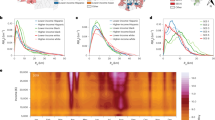Abstract
In this paper, we explore the analogy between the refugees’ drownings in the sea and the earthquakes’ occurrences and focus on the aspect that characterizes the statistics of their spatial and temporal successions. The latter is shown to parallel the spatial distribution of consecutive drowning events with the difference that the former exhibits short-range behavior below \( \kappa = 4\,\mathrm{km}\) and it is characterized by scale-free statistics, as well as finite size scaling beyond \(\kappa = 4\,\mathrm{km}\), with a critical exponent \(\delta \approx 0.5\), falling within the range of the earthquakes’ \(\delta = 0.6 \pm 0.2\), while the distribution of events’ rates exhibits no similarity with that of the earthquakes. Finally, the events’ velocity distribution is also recovered. \(\kappa \) is suspected to be related to the range of mobile network’s coverage and thus effectively represents a cutoff in the ability of picking up signals on drownings in the sea.








Similar content being viewed by others
Data Availability Statement
This manuscript has associated data in a data repository. [Authors’ comment: The data used in the paper are available for download at the following link: https://mailaub-my.sharepoint.com/:x:/g/personal/sn62_aub_edu_lb/ESVIF_Zdw3ROn5ypLKypk00BkdpjBL3X8rOanTB0rAZUMg?e=KPsnOV].
References
R. Dendy, P. Helander, M. Tagger, Self-organised criticality in astrophysical accretion systems. Phys. Scripta 1999(T82), 133 (1999)
P. Bak, C. Tang, Earthquakes as a self-organized critical phenomenon. J. Geophys. Res. Solid Earth 94(B11), 15635–15637 (1989)
J. Davidsen, G. Kwiatek, Earthquake interevent time distribution for induced micro-, nano-, and picoseismicity. Phys. Rev. Lett. 110(6) (2013)
A. Corral, Long-term clustering, scaling, and universality in the temporal occurrence of earthquakes. Phys. Rev. Lett. 92(10) (2004)
M.C. Stefanini, Spatio-temporal analysis of a complex landslide in the northern apennines (italy) by means of dendrochronology. Geomorphology 63(3–4), 191–202 (2004)
J.A. Backer, J. Wallinga, Spatiotemporal analysis of the, ebola epidemic in west africa. PLoS Comput. Biol. 12(12), 2016 (2014)
Q. Huang, L. Hu, Q.-B. Liao, J. Xia, Q.-R. Wang, H.-J. Peng, Spatiotemporal analysis of the malaria epidemic in mainland china, 2004–2014. The Am. J. Trop. Med. Hyg. 97(2), 504–513 (2017)
B.D. Malamud, G. Morein, D.L. Turcotte, Forest fires: an example of self-organized critical behavior. Science 281(5384), 1840–1842 (1998)
H. Stanley, L. Amaral, S.V. Buldyrev, P. Gopikrishnan, V. Plerou, M. Salinger, Self-organized complexity in economics and finance. Proc. Nat. Acad. Sci. 99(suppl 1), 2561–2565 (2002)
R.J. Wijngaarden, M.S. Welling, C.M. Aegerter, M. Menghini, Avalanches and self-organized criticality in superconductors. The Eur. Phys. J. B-Conden. Matter Complex Syst. 50(1–2), 117–122 (2006)
J. Hesse, T. Gross, Self-organized criticality as a fundamental property of neural systems. Front. Syst. Neurosci. 8, 166 (2014)
D.R. Chialvo, Emergent complex neural dynamics. Nat. Phys. 6(10), 744–750 (2010)
C. Bedard, H. Kroeger, A. Destexhe, Does the 1/f frequency scaling of brain signals reflect self-organized critical states?. Phys. Rev. Lett. 97(11) (2006)
H.J. Jensen, Self-Organized Criticality: Emergent Complex Behavior in Physical and Biological Systems, vol. 10 (Cambridge University Press, 1998)
A.L. Goldberger, L.A. Amaral, J.M. Hausdorff, P.C. Ivanov, C.-K. Peng, H.E. Stanley, Fractal dynamics in physiology: alterations with disease and aging. Proc. Natl. Acad. Sci. 99(suppl 1), 2466–2472 (2002)
D.L. Turcotte, Fractals and Chaos in Geology and Geophysics (Cambridge University Press, 1997)
E.-J. Wagenmakers, S. Farrell, R. Ratcliff, Human cognition and a pile of sand: a discussion on serial correlations and self-organized criticality. J. Exp. Psychol. Gen. 134(1), 108 (2005)
R. Ramos, R. Sassi, J. Piqueira, Self-organized criticality and the predictability of human behavior. New Ideas Psychol. 29(1), 38–48 (2011)
T. Kron, T. Grund, Society as a self-organized critical system. Cybern. Human Know. 16(1–2), 65–82 (2009)
S. Galam, Sociophysics: a review of galam models. Int. J. Mod. Phys. C 19(03), 409–440 (2008)
J. Davidsen, M. Paczuski, Analysis of the spatial distribution between successive earthquakes. Phys. Rev. Lett. 94(4) (2005)
S. Najem, G. Faour, Debye-hückel theory for refugees’ migration. EPJ Data Sci. 7(1), 1–9 (2018)
J.H. Ratcliffe, Aoristic signatures and the spatio-temporal analysis of high volume crime patterns. J. Quan. Criminol. 18(1), 23–43 (2002)
L. Alessandretti, P. Sapiezynski, S. Lehmann, and A. Baronchelli, “Multi-scale spatio-temporal analysis of human mobility,” PloS one, vol. 12, no. 2, 2017
T. U. M. A. International Organization for Migration, “The central mediterranean route: Migrant fatalities january 2014 - july 2017.”
M. Biggs, Strikes as forest fires: Chicago and paris in the late nineteenth century. Am. J. Sociol. 110(6), 1684–1714 (2005)
H. Watt, M. Rice-Oxley, and D. Taylor, “Drowned, restrained, shot: how these migrants died for a better life,” Jun 2018
L. Tondo, “Italian coastguard finds bodies of migrants who drowned at sea,” Oct 2019
“Watch the med.”
R. Bullock, “Great circle distances and bearings between two locations,” MDT, June, vol. 5, 2007
G.M. Viswanathan, The Physics of Foraging: An Introduction to Random Searches and Biological Encounters (Cambridge University Press, 2011)
Author information
Authors and Affiliations
Corresponding author
Rights and permissions
About this article
Cite this article
Khederlarian, A., Grant, M., Halkort, M. et al. Analysis of the refugees’ drowning events:. Eur. Phys. J. Plus 136, 619 (2021). https://doi.org/10.1140/epjp/s13360-021-01616-4
Received:
Accepted:
Published:
DOI: https://doi.org/10.1140/epjp/s13360-021-01616-4




